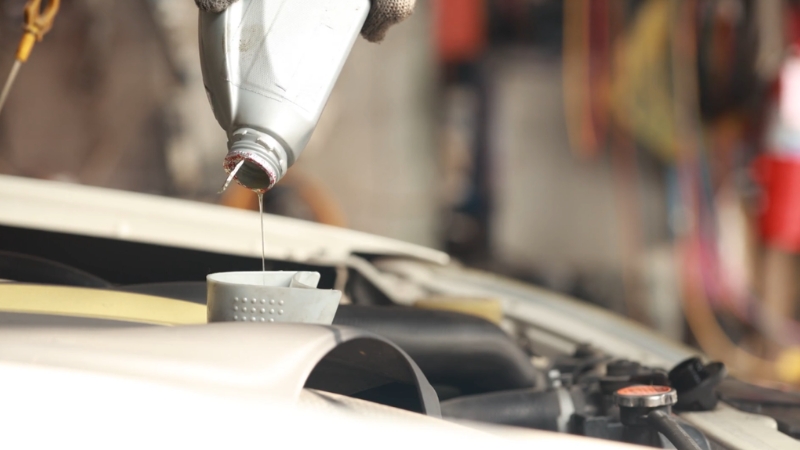
Share Post:
Coolant puddles beneath a parked vehicle often trigger a rush of concern. Nobody enjoys the sight of that bright fluid staining the driveway, raising fears of engine damage and expensive repairs.
A leak that comes from beneath a car’s body can lead to more than frustration and inconvenience. Left unchecked, it can cause serious engine trouble.
The good news: spotting the problem early, knowing where it comes from, and tackling it head-on can make a big difference. Let’s check out what you can do in case you notice this puddle.
Table of Contents
ToggleSpotting a Leak Early On

Catching a coolant leak before everything spirals out of control can feel like nipping a brewing storm in the bud. A small green, orange, or pink pool under the engine block is usually the first sign.
The fluid tends to stand out against pavement, and a slight sweet smell may be present as well. Such visual and olfactory cues rarely lie. Engine temperature gauges and warning lights on the dashboard also provide useful hints.
When something is off with coolant circulation, the engine often overheats faster than normal, and a warning light might flash. Even minor changes should not be dismissed.
Common Sources Of Leakage
Few car owners expect to deal with coolant leaks. Yet, those who drive daily eventually face a variety of maintenance issues. Coolant leaks appear for many reasons. Consider the major culprits behind that growing puddle:
Radiator Troubles
An aging radiator is a prime suspect. Time, vibrations, debris on the road, and wear all take a toll. Corrosion, cracks, and even small punctures let coolant escape.
Radiators live at the front of the engine bay, enduring blasts of hot air, moisture, and mechanical stress. All that stress can eventually open small pathways for fluid to seep out. Once that happens, the puddles form and the engine’s temperature control system struggles.
Hose Failures
Those flexible rubber hoses carrying coolant between the engine block and radiator do their job quietly. Over many miles and countless heat cycles, they become brittle. Small cracks or splits may appear, allowing coolant to drip onto the ground.
In some cases, clamps that hold hoses in place loosen or corrode, magnifying the problem. It might start with a tiny drip, but sooner or later, a steady stream can appear.
Water Pump Woes

The water pump sits at the heart of the cooling system, pushing coolant through the engine to keep temperatures steady. A failing pump can develop leaks around its seals.
Signs often show up at the front of the engine, and coolant might pool in that area. Losing coolant in such a fashion can lead to severe overheating if not addressed promptly.
Clamps And Their Quirks
Small but mighty clamps hold hoses secure. They may look insignificant, yet those metal fasteners keep coolant from spraying everywhere. Over time, clamps loosen due to thermal expansion and contraction.
Corrosion also sets in. A tiny gap at a hose-to-engine or hose-to-radiator junction can allow fluid to ooze out, leaving telltale stains underneath the vehicle.
Blown Head Gasket
A head gasket separates engine cylinders and ensures proper containment of engine fluids. A faulty one creates all sorts of chaos. Sometimes, coolant slips into the engine’s combustion chambers, leading to thick white exhaust smoke.
Other times, fluid drips outside the engine. A blown head gasket is more serious and often requires a professional touch. Ignoring such a problem often leads to major engine damage down the road.
Coolant Reservoir Fractures
Plastic coolant reservoirs, usually positioned near the radiator, store extra fluid. Over time, plastic parts can crack due to heat, vibrations, or simple aging.
When that container fails, coolant leaks out in visible ways. Spotting a cracked reservoir is usually straightforward: look for streaks of dried coolant around it or fluid dripping down onto the ground.
Heater Core Corrosion
Inside the dashboard sits the heater core. It warms the cabin by circulating hot coolant. Corrosion or damage inside the core lets coolant escape into places it should never go.
The result might be a sweet smell inside the car, foggy windows, or damp carpets. Although the leak may not always drip directly under the engine compartment, fluid still ends up under the car once gravity takes over.
Warning Signals And Detection Methods

Leaks rarely remain undetected for long. Drivers paying close attention often notice warning signs:
- Bright Fluid Under The Car: Pools of green, pink, or orange fluid signal coolant trouble.
- Sweet, Syrupy Smell: That odor often signals a coolant leak even before puddles form.
- Temperature Gauge Spike: Sudden increases in engine temperature or dashboard warning lights.
- Foggy Windows Inside The Cabin: Possible heater core issue allowing coolant vapor into the car’s interior.
Immediate Steps To Take
A coolant leak is not a scenario anyone wants to face, especially far from home. Still, reacting correctly minimizes damage.
- Pull Over Safely: Once a coolant leak is suspected, find a safe spot away from traffic. Turn off the engine, allowing it to cool.
- Check Fluid Levels: After the engine cools down, examine the coolant reservoir. If levels look low, adding fresh coolant temporarily helps. Keep in mind that refilling does not solve the underlying problem.
- Avoid Driving Long Distances: Limping along with a known coolant leak can result in serious engine overheating, warping of metal parts, and expensive repairs.
- Seek Professional Help: A qualified mechanic can pinpoint the exact cause. Attempting to fix a complicated leak at home might cause more harm than good, especially when dealing with components like head gaskets or heater cores.
Preventing Future Leaks

Regular upkeep prevents many coolant leaks. Smart prevention measures save money, time, and headaches. Implementing a maintenance strategy protects the engine and keeps drivers on the road with fewer interruptions.
Maintenance Routines
Establishing a consistent schedule for inspecting critical cooling system parts helps catch issues before fluid starts dripping. Consider a routine that includes:
- Periodic Radiator Checks: Inspect for signs of rust, corrosion, or damage.
- Hose Integrity Tests: Squeeze hoses gently to feel for brittleness or cracks.
- Clamp Tightening: Make sure clamps are secure, replacing any that show corrosion.
- Water Pump Assessment: Ask a trusted mechanic to examine the pump’s condition at regular service intervals.
Proper Coolant Use
Not all coolant types are the same. Each vehicle’s manufacturer recommends a specific coolant blend and type, chosen for compatibility and corrosion resistance.
Using coolant designed for a particular engine promotes smoother cooling, fewer internal rust spots, and fewer leaks. Paying attention to coolant color and changing it according to the recommended interval ensures longevity of engine components.
Keep an eye on coolant levels frequently. If levels drop below normal, top up promptly, then investigate any sudden drops to prevent ongoing leakage issues.
Environmental Considerations
Coolant poses hazards beyond engine damage. It is toxic to pets, wildlife, and even children who might be drawn by its bright color and sweet smell. Leaks on driveways or streets eventually wash into storm drains, affecting local water sources.
Taking the time to clean up spills and dispose of old coolant responsibly prevents harm to the environment. Using a sealed container for transportation and disposing of coolant at a certified recycling center is a responsible step.
Extra Tips And Advice

Anyone who has handled car maintenance tasks knows the value of a well-stocked toolkit and basic mechanical knowledge. Although major coolant leaks require professional help, a minor hose drip or a loose clamp might be manageable with the right guidance. Consider the following tips:
- Keep Spare Coolant On Hand: A small bottle in the trunk provides peace of mind during emergencies.
- Watch For Warning Signs: Pay attention to unusual smells, puddles, or rising engine temperatures. Early action often prevents expensive damage.
- Follow Service Intervals: Stick to the recommended maintenance schedule in the owner’s manual, focusing on coolant changes and inspections at the suggested intervals.
- Record Repairs And Checks: Jot down dates of inspections, coolant top-ups, or replaced parts. A personal maintenance log helps spot patterns, ensuring that small issues do not evolve into bigger ones.
Wrapping It Up
Coolant leaks, especially those appearing under the vehicle, represent serious matters. Prompt action, proper diagnosis, and preventive steps can keep engines running smoothly for years.
Nobody wants to deal with an overheated engine on a deserted road, nor spend a fortune on major repairs caused by a leak that went ignored. A proactive approach, combined with attention to warning signs, pays off in the long run.
Focus on addressing any hint of leaking coolant as soon as possible. Speak with a professional mechanic when symptoms appear. Follow recommended maintenance routines and keep a close eye on fluid levels.
Such mindful behavior ensures safer travels, fewer worries, and a longer lifespan for the vehicle’s engine. After all, a well-maintained cooling system is key to enjoying smooth drives and greater peace of mind.
Related Posts:
- White Smoke Coming from Your Car's Exhaust? Causes…
- Why Does My Car Smell Like Gas? Common Causes and Solutions
- Why Does My Car Squeak When Turning? Common Causes…
- Power Steering Fluid Leak? Here’s How to Repair It…
- How Often to Change Coolant - Tips For a Healthy Engine
- Subaru CarPlay Not Working: 5 Common Reasons & Solutions








